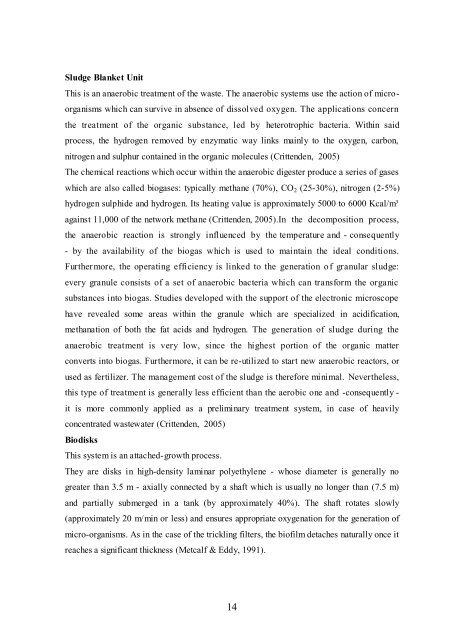Quds University Small Scale Waste Water Treatment Plants in West ...
Quds University Small Scale Waste Water Treatment Plants in West ...
Quds University Small Scale Waste Water Treatment Plants in West ...
You also want an ePaper? Increase the reach of your titles
YUMPU automatically turns print PDFs into web optimized ePapers that Google loves.
Sludge Blanket Unit<br />
This is an anaerobic treatment of the waste. The anaerobic systems use the action of microorganisms<br />
which can survive <strong>in</strong> absence of dissolved oxygen. The applications concern<br />
the treatment of the organic substance, led by heterotrophic bacteria. With<strong>in</strong> said<br />
process, the hydrogen removed by enzymatic way l<strong>in</strong>ks ma<strong>in</strong>ly to the oxygen, carbon,<br />
nitrogen and sulphur conta<strong>in</strong>ed <strong>in</strong> the organic molecules (Crittenden, 2005)<br />
The chemical reactions which occur with<strong>in</strong> the anaerobic digester produce a series of gases<br />
which are also called biogases: typically methane (70%), CO 2 (25-30%), nitrogen (2-5%)<br />
hydrogen sulphide and hydrogen. Its heat<strong>in</strong>g value is approximately 5000 to 6000 Kcal/m³<br />
aga<strong>in</strong>st 11,000 of the network methane (Crittenden, 2005).In the decomposition process,<br />
the anaerobic reaction is strongly <strong>in</strong>fluenced by the temperature and - consequently<br />
- by the availability of the biogas which is used to ma<strong>in</strong>ta<strong>in</strong> the ideal conditions.<br />
Furthermore, the operat<strong>in</strong>g efficiency is l<strong>in</strong>ked to the generation of granular sludge:<br />
every granule consists of a set of anaerobic bacteria which can transform the organic<br />
substances <strong>in</strong>to biogas. Studies developed with the support of the electronic microscope<br />
have revealed some areas with<strong>in</strong> the granule which are specialized <strong>in</strong> acidification,<br />
methanation of both the fat acids and hydrogen. The generation of sludge dur<strong>in</strong>g the<br />
anaerobic treatment is very low, s<strong>in</strong>ce the highest portion of the organic matter<br />
converts <strong>in</strong>to biogas. Furthermore, it can be re-utilized to start new anaerobic reactors, or<br />
used as fertilizer. The management cost of the sludge is therefore m<strong>in</strong>imal. Nevertheless,<br />
this type of treatment is generally less efficient than the aerobic one and -consequently -<br />
it is more commonly applied as a prelim<strong>in</strong>ary treatment system, <strong>in</strong> case of heavily<br />
concentrated wastewater (Crittenden, 2005)<br />
Biodisks<br />
This system is an attached-growth process.<br />
They are disks <strong>in</strong> high-density lam<strong>in</strong>ar polyethylene - whose diameter is generally no<br />
greater than 3.5 m - axially connected by a shaft which is usually no longer than (7.5 m)<br />
and partially submerged <strong>in</strong> a tank (by approximately 40%). The shaft rotates slowly<br />
(approximately 20 m/m<strong>in</strong> or less) and ensures appropriate oxygenation for the generation of<br />
micro-organisms. As <strong>in</strong> the case of the trickl<strong>in</strong>g filters, the biofilm detaches naturally once it<br />
reaches a significant thickness (Metcalf & Eddy, 1991).<br />
14




